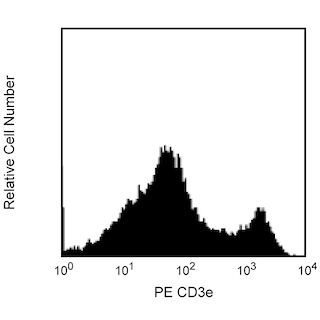Old Browser
Looks like you're visiting us from {countryName}.
Would you like to stay on the current country site or be switched to your country?


.png)

Multicolor flow cytometric analysis of CD223 expressed on activated splenocytes. Splenocytes from C57BL/6 mice were activated in culture for 3 days in the presence of immobilized Purified NA/LE Hamster Anti-Mouse CD3e antibody (Cat. No. 553057). The cells were then harvested and stained with PE Hamster Anti-Mouse CD3e antibody (Cat. No. 553063/553064/561824) and either APC Rat IgG1, κ Isotype Control (Cat. No. 554686, Left Panel) or APC Rat Anti-Mouse CD223 antibody (Cat. No. 562346, Right Panel). Two-color flow cytometric dot plots showing the correlated expression patterns of CD3 versus CD223 (or Ig Isotype Control staining) were derived from gated events with the forward and side light-scatter characteristics of viable activated splenocytes. Flow cytometry was performed using a BD™ LSR II Flow Cytometer System.
.png)

BD Pharmingen™ APC Rat Anti-Mouse CD223
.png)
Regulatory Status Legend
Any use of products other than the permitted use without the express written authorization of Becton, Dickinson and Company is strictly prohibited.
Preparation And Storage
Product Notices
- Since applications vary, each investigator should titrate the reagent to obtain optimal results.
- An isotype control should be used at the same concentration as the antibody of interest.
- Caution: Sodium azide yields highly toxic hydrazoic acid under acidic conditions. Dilute azide compounds in running water before discarding to avoid accumulation of potentially explosive deposits in plumbing.
- This APC-conjugated reagent can be used in any flow cytometer equipped with a dye, HeNe, or red diode laser.
- For fluorochrome spectra and suitable instrument settings, please refer to our Multicolor Flow Cytometry web page at www.bdbiosciences.com/colors.
- Please refer to www.bdbiosciences.com/us/s/resources for technical protocols.
Companion Products

.png?imwidth=320)




The C9B7W antibody monoclonal antibody specifically binds to an epitope in the D2 domain of CD223 (LAG3), the 70-kDa protein encoded by Lymphocyte-activation gene 3 (Lag3). A fusion protein consisting of the entire extracellular region of mouse LAG3 with mouse IgG1 was used as immunogen. CD223 is a type-I membrane protein with four extracellular Ig-like domains; it is structurally homologous to CD4; and, like CD4, it binds MHC class II molecules. However, unlike CD4, it is not expressed on resting human and mouse T lymphocytes. In the mouse, as previously described in the human, CD223 expression is upregulated on T lymphocytes (both CD4+ and CD8+) activated through the T-cell receptor (TCR) and on IL-2-activated NK (LAK) cells, and it is not detected on B cells, dendritic cells, or Phorbol 12-myristate 13-acetate (PMA)-stimulated splenocytes. Studies on human peripheral T lymphocytes suggest that CD223 associates with the TCR to downregulate TCR signaling. In contrast, in vivo and in vitro evaluations of vaccination protocols in mice suggest that CD223 promotes immune responses by activating antigen-presenting cells. Furthermore, NK cells of Lag3-/- mice display defects in their capacity to kill certain tumor cells. Mouse CD223 also has been demonstrated to contribute to the suppressor function of T regulatory cells and the C9B7W antibody has been shown to inhibit this function in vitro and in vivo. Therefore, CD223 appears to play complex roles in the regulation of immune responses. Although the C9B7W antibody is unable to block the binding of MHC class II-IgG2a fusion protein to CD223, it is able to block the CD223-mediated inhibition of IL-2 production by a T-cell hybridoma responding to antigen.

Development References (3)
-
Huang CT, Workman CJ, Flies D, et al. Role of LAG-3 in regulatory T cells. Immunity. 2004; 21(4):503-513. (Clone-specific: Blocking, Flow cytometry). View Reference
-
Miyazaki T, Dierich A, Benoist C, Mathis D. Independent modes of natural killing distinguished in mice lacking Lag3. Science. 1996; 272(5260):405-408. (Biology). View Reference
-
Workman CJ, Rice DS, Dugger KJ, Kurschner C, Vignali DA. Phenotypic analysis of the murine CD4-related glycoprotein, CD223 (LAG-3). Eur J Immunol. 2002; 32(8):2255-2263. (Immunogen: Blocking, Cell culture, Flow cytometry, Functional assay, Inhibition). View Reference
Please refer to Support Documents for Quality Certificates
Global - Refer to manufacturer's instructions for use and related User Manuals and Technical data sheets before using this products as described
Comparisons, where applicable, are made against older BD Technology, manual methods or are general performance claims. Comparisons are not made against non-BD technologies, unless otherwise noted.
For Research Use Only. Not for use in diagnostic or therapeutic procedures.
Report a Site Issue
This form is intended to help us improve our website experience. For other support, please visit our Contact Us page.